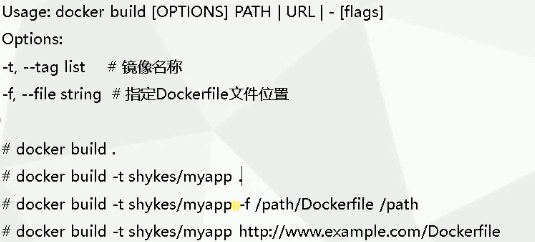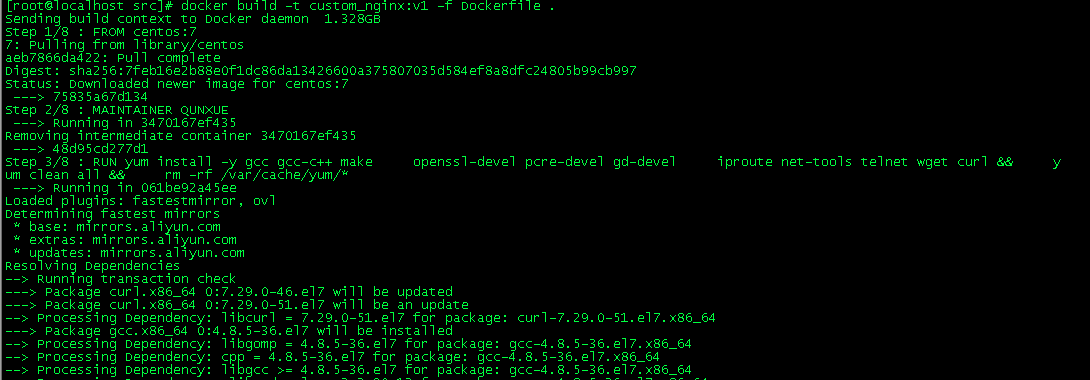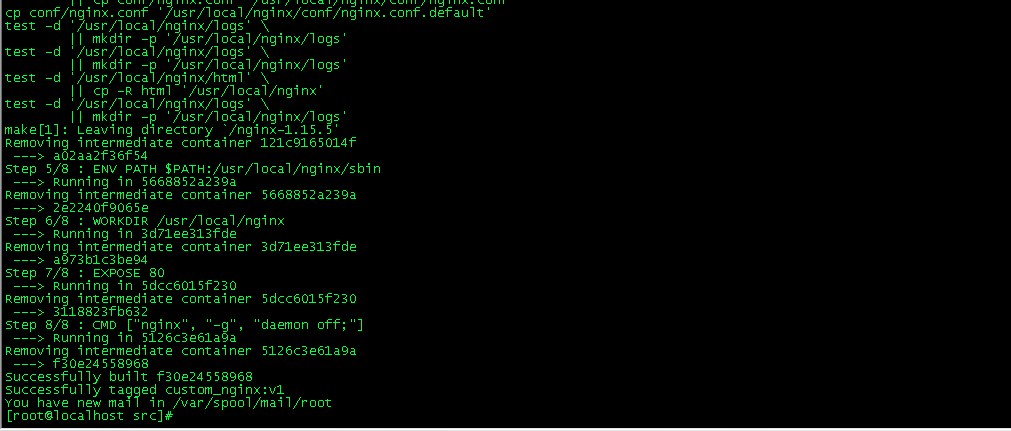9、Dockerfile实战-Nginx
作者:@skyflask
转载本文请注明出处:https://www.cnblogs.com/skyflask/p/10068420.html
目录
一、构建Nginx镜像
1、 Nginx安装步骤
2、Dockerfile文件编写
3、注意事项及dockerfile编写最佳实践
4、构建基础镜像(nginx)
5、基于基础镜像测试
上一节我们详解Dockerfile之后,现在来进行实战。我们通过docker build来进行镜像制作。
build有如下选项:
1 2 3 4 5 6 7 8 9 10 11 12 13 14 15 16 17 18 19 20 21 22 23 24 25 26 27 28 29 30 31 32 33 34 35 36 | [root@localhost ~a]# docker build --helpUsage: docker build [OPTIONS] PATH | URL | -Build an image from a DockerfileOptions: --add-host list Add a custom host-to-IP mapping (host:ip) --build-arg list Set build-time variables --cache-from strings Images to consider as cache sources --cgroup-parent string Optional parent cgroup for the container --compress Compress the build context using gzip --cpu-period int Limit the CPU CFS (Completely Fair Scheduler) period --cpu-quota int Limit the CPU CFS (Completely Fair Scheduler) quota -c, --cpu-shares int CPU shares (relative weight) --cpuset-cpus string CPUs in which to allow execution (0-3, 0,1) --cpuset-mems string MEMs in which to allow execution (0-3, 0,1) --disable-content-trust Skip image verification (default true) -f, --file string Name of the Dockerfile (Default is 'PATH/Dockerfile') --force-rm Always remove intermediate containers --iidfile string Write the image ID to the file --isolation string Container isolation technology --label list Set metadata for an image -m, --memory bytes Memory limit --memory-swap bytes Swap limit equal to memory plus swap: '-1' to enable unlimited swap --network string Set the networking mode for the RUN instructions during build (default "default") --no-cache Do not use cache when building the image --pull Always attempt to pull a newer version of the image -q, --quiet Suppress the build output and print image ID on success --rm Remove intermediate containers after a successful build (default true) --security-opt strings Security options --shm-size bytes Size of /dev/shm -t, --tag list Name and optionally a tag in the 'name:tag' format --target string Set the target build stage to build. --ulimit ulimit Ulimit options (default [])[root@localhost ~]# |
主要参数有:
1 2 | -t, --tag list #给镜像打tag,比如nginx:v1-f, --file string # -f Dockerfile文件名字,默认为当前路径下的Dockerfile |

一、构建Nginx镜像
1、 Nginx安装步骤
- 安装依赖包
- 编译安装nginx三步骤:编译、make、make install
- 配置配置文件和环境变量
2、Dockerfile文件编写
1 2 3 4 5 6 7 8 9 10 11 12 13 14 15 16 17 18 19 20 21 22 23 24 | FROM centos:7MAINTAINER QUNXUERUN yum install -y gcc gcc-c++ make \ openssl-devel pcre-devel gd-devel \ iproute net-tools telnet wget curl && \ yum clean all && \ rm -rf /var/cache/yum/*RUN wget http://nginx.org/download/nginx-1.15.5.tar.gz && \ tar zxf nginx-1.15.5.tar.gz && \ cd nginx-1.15.5 &&\ ./configure --prefix=/usr/local/nginx \ --with-http_ssl_module \ --with-http_stub_status_module && \ make -j 4 && make install && \ rm -rf /usr/local/nginx/html/* && \ echo "ok" >> /usr/local/nginx/html/status.html && \ cd / && rm -rf nginx-1.15.5* && \ ln -sf /usr/share/zoneinfo/Asia/Shanghai /etc/localtimeENV PATH $PATH:/usr/local/nginx/sbinCOPY nginx.conf /usr/local/nginx/conf/nginx.confWORKDIR /usr/local/nginxEXPOSE 80CMD ["nginx", "-g", "daemon off;"] |
3、注意事项及dockerfile编写最佳实践
a、尽量让镜像文件更小
清理残留文件,比如build完成后,要删掉源码包、yum缓存等。
b、尽量减少Dockerfile指令
因为我们知道,一个Dockerfile指令,就是一层镜像,我们使用shell里面的&&符号进行拼接成一行,让RUN指令尽可能少。
c、在测试中编写Dockerfile
我们随便启动一个容器:docker run -it centos,进入容器后,就可以对我们写的Dockerfile指令进行逐行执行
d、Dockerfile常用指令
基本上按照表格中的顺序进行编写

4、构建基础镜像(nginx)
1 | docker build -t custom_nginx:v1 -f dockerfile-nginx . |
注意:命令最后面一个点,用于指定docker build的上下文,.为当前目录,就是在build镜像时,如果有涉及到需要拷贝文件之类的,都是从当前目录拷贝。


可以看到,最后我们构建成功了。

我们可以基于此镜像作为基础镜像进行容器构建:
1 2 | [root@localhost src]# docker run -itd -h web001 -p 8889:80 custom_nginx:v1 2ad7070295ed0d4cc97319696176e3bfaf75dde9ccc54e3990e251907ce16ebd |
尝试访问我们自己写的主页,status.html:

说明我们的启动的docker容器是预想中的效果,very good!
5、基于基础镜像测试
我们制作了基础镜像,此时,我们可以基于此基础镜像进行测试环境发布了。
编写Dockerfile
1 2 | FROM custom_nginx:v1COPY index.html /usr/local/nginx/html |
这里我们把index.html文件作为整个测试环境的内容,当然,测试环境肯定不止一个文件,我们这里用于测试。
1 | echo "This is My First Project,Welcome! Guy." >index.html |
基于基础镜像进行新镜像构建:

基于新镜像构建容器:
1 2 3 | [root@localhost src]# docker run -itd -h custom_nginxv2 -p 1234:80 custom_nginx:v2 155225793ee06151601047152a1fe25f02691001de0b85d3d017c5d4f657ad7f[root@localhost src]# |
测试:访问宿主机的1234端口

一切都是期望的样子!



【推荐】国内首个AI IDE,深度理解中文开发场景,立即下载体验Trae
【推荐】编程新体验,更懂你的AI,立即体验豆包MarsCode编程助手
【推荐】抖音旗下AI助手豆包,你的智能百科全书,全免费不限次数
【推荐】轻量又高性能的 SSH 工具 IShell:AI 加持,快人一步
· 从 HTTP 原因短语缺失研究 HTTP/2 和 HTTP/3 的设计差异
· AI与.NET技术实操系列:向量存储与相似性搜索在 .NET 中的实现
· 基于Microsoft.Extensions.AI核心库实现RAG应用
· Linux系列:如何用heaptrack跟踪.NET程序的非托管内存泄露
· 开发者必知的日志记录最佳实践
· winform 绘制太阳,地球,月球 运作规律
· AI与.NET技术实操系列(五):向量存储与相似性搜索在 .NET 中的实现
· 超详细:普通电脑也行Windows部署deepseek R1训练数据并当服务器共享给他人
· 上周热点回顾(3.3-3.9)
· AI 智能体引爆开源社区「GitHub 热点速览」